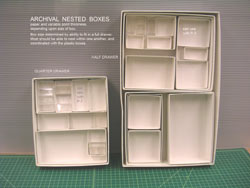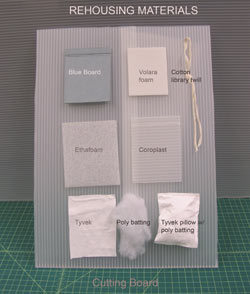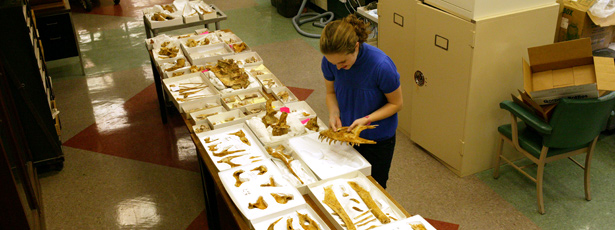Housing
Good collection practices require that specimens be stored in conditions that will promote their long-term preservation. Providing and maintaining these conditions at the building, room and cabinet level is discussed in greater detail in the PaleoPortal Collections Management Module. Fossil preparators are more commonly involved in developing storage solutions for individual specimens. There are good reasons why this is the case. A preparator’s familiarity with a particular specimen after completing their work makes them the ideal person to provide a custom storage mount, while experience of not only working with specimens, but also seeing how they are handled and used by others, makes preparators appropriate for carrying out storage mount projects.
For more information on specimen housing and storage, the PaleoPortal Collection Management Module.
Specimen Storage
Specimens in storage can suffer a number of types of mechanical damage:
- An irregular shaped object placed on a flat surface rests on only a few points of contact resulting in crushing and abrasion at these points.
- Gravity can cause specimens to break under their own weight
- Vibrations can be transmitted to specimens
- Moving cabinet drawers can cause specimens to roll or slide into each other or the drawers
- Dragging heavy specimens on shelves can cause abrasions
Whether specimens are housed in vials, trays, boxes, pallets or shelves, properly designed supports can help reduce these problems by:
- Supporting the specimen as completely as possible
- Limiting movement of the specimen in any direction
- Padding the specimen to limit shocks and vibrations
Principles for storage mounts
Construction of storage mounts, whether for an individual specimen or for a large group have some basic tenets in common:
Think long-term
Archival materials and the time involved in making a good mount are costly and so it is important that mounts be able to withstand the wear and tear involved in handling a box and specimen. Will the mount still function in 50 years time? Are there small steps like rounding corners on foam ‘risers’ or bumpers that will allow them to last a little longer?
Large as necessary, as small as possible
This maxim recognizes that almost all collections have serious space constraints. Storage mounts must be big enough to adequately protect the specimen without using any unnecessary space. Custom solutions or having a variety of box/tray sizes allows for the most efficient use of space.
Minimize handling
While specimens can sustain damage in storage over time from vibration, rolling, or slumping under their own weight, it is handling during study and use that most commonly results in damage. A good storage mount should minimize the need for direct handling of a specimen. For instance, skulls and jaw fragments might be best housed “teeth up” so that they can be studied without removal from their mount.
Multi-directional
A well designed mount should make clear how the specimen should be replaced. Thumbnail images in the box or tray can be used to guide researchers in returning specimens properly in their place.
Storage materials
The best materials to use for making mounts are inert, meaning non-reactive and not prone to off-gassing. Generally the following materials are safe to use for long-term housing:
- Polyethylene
- Polypropylene
- Polystyrene
- Natural unbleached cotton
- Acid-free paper
- Mylar
- Acrylics
And materials that might off-gas the following would not be considered safe for storage:
- Formaldehyde
- Acids
- Peroxides
- Amines
- Plasticizers
- Migrating dyes
There are many suppliers of archival preservation grade materials and they can easily be bought in small quantities by individual collectors. Institutions that are undertaking large re-housing projects can often arrange for bulk purchases (see the Collection Management module for a link to information on archival vendors).
Storage techniques
Very small specimens
The smallest fossil specimens (e.g., single mammal teeth and other pieces too small to have the specimen number written on them) pose a distinct set of challenges. Generally they are stored in gel caps or adhered to cork embedded pins within a glass vial; there are advantages and disadvantages to each technique and the decision is often based on the preference of staff working with the specimens and the needs of their research.
Gel caps – easy to use and inexpensive but are affected by moisture and become brittle over time, leading to breakage. For this reason they should either be placed within another closed container to protect them or replaced with polypropylene capsules; these are more expensive but are more stable over time.
Pinned specimens – allow for easy handling but can fail, leading to damage or loss of the specimen if attention is not paid to a number of different criteria.
- Any adhesive will leave some residue and may also cover some information on the specimen – this should be taken into account if this method of housing is being considered.
- Using an easily reversible adhesive or adherent is important, to allow for removal of the specimen if necessary. Paraloid B-72, Butvar, PVAC or even microcrystalline wax are suitable choices. For more on adhesives and their properties see the Adhesives and Consolidants page.
- Pin length – long pins may cause the specimen to fly off if the pin is bent or flexed. Long pins may also increase the chance of the specimen hitting the side of the vial when being removed, causing damage to the specimen.
- Stopper material – cork is sensitive to environmental conditions and can shrink over time, loosening the fit of the stopper. Foam such as polyethylene can be used but may lose its elasticity as it ages. Polyethylene or polypropylene stoppers are more expensive but, if found in appropriate sizes, are the best long-term solution.
For more information on pinning see: “Some Techniques and Procedures for Microvertebrate Preparation”. Scott K. Madsen, in Techniques for Recovery and Preparation of Microvertebrate Fossils. Richard Cifelli, editor. Oklahoma Geological Survey, Special Publication 96-4. 1996.
Small specimens
Small specimens are best housed in boxes or trays. Using standardized box sizes allows them to be nested together neatly in a cabinet drawer without wasting space. Open trays or boxes are convenient, but it is important that they are not so shallow that pieces can spill from one tray into another. Box types include:
- Polystyrene – this material will become brittle over time and dissolves in strong polar solvents (e.g., acetone); however, it is still commonly used for small specimen boxes
- PET (polyethylene terephtalate) boxes) – these are not very rigid and are unsuitable for all but the lightest specimens
- Polyester – these too may not be appropriate for heavier small specimens. They are also more expensive than polystyrene.
- Polypropylene or polyethylene – off-the-shelf products will be prone to off-gassing.
- Paper – rag or acid-free boxes can be used as trays with no lid. Some collections will use non-archival products with an archival lining such as Ethafoam.


Boxes can be lined using archival foam products such as Ethafoam or Volara. Tyvek and polyester batting can also be used if additional cushioning is needed. Cotton wool or newspaper, which can snag specimens and provide a food source for insect pests should not be used for padding.
Medium sized specimens
Medium sized specimens require some padding and support in storage to reduce rolling and vibration when drawers are moved and to ensure that specimens do not break under their own weight. Pallets or trays lined with Ethafoam and fitted with bumpers of closed cell foams like Volara or round or triangular polyethylene form backer rod adhered with hot-melt glue can be easily and quickly constructed. See the PaleoPortal Collection Management module for additional information on techniques for archaeological and ethnographic conservation that can be easily adapted for use on fossil specimens.
Large and oversize specimens
Large specimens generally require a rigid support to allow them to be safely moved. These specimens are often stored on open shelving. Care must be taken when wood or wood-products like MDF particle board are used in construction of these mounts as they can promote acid attack. When specimens are too heavy to use plank foam for support, plaster and a thin foam lining may be used instead. The heaviest specimens may require that the support be constructed to be moved using forklifts and/or pallet jacks.
Resources
For more specifics on these housing methods download the PowerPoint presentation by Marilyn Fox and Vicki Yarborough Fitzgerald, A Review of Vertebrate Fossil Support (and storage) Systems at the Yale Peabody Museum of Natural History or the associated pdf document.
Download a PowerPoint presentation on Housing Type Specimens by Ivy Rutzky of the American Museum of Natural History. This technique can be adapted for a wide variety of specimens. Also download her jpg images annotated with information on the products pictured.
- Rehousing Materials
- Rehousing Tools
- Tri-rod & Boxes
- Nesting White Paper Boxes
Download a PowerPoint presentation by AMNH preparator Amy Davidson on Cavity Mounts.
Access the following presentations on the Society for Vertebrate Paleontology website
- Vertebrate microfossil storage, the basics, and a new technique, Matthew Smith, Kimberly, OR
- A simple process for fabricating small display mounts, Matthew Brown, Constance Van Beek, James Holstein, Field Museum of Natural History, Chicago, IL – abstract available on the Preparators page under the 2006 presentations
- A Technique To Create Form-Fitted, Padded Plaster Jackets For Conserving Vertebrate Fossil Specimens a 2005 SVP Preparators Session paper by Jabo, S.J.; Kroehler, P.A.; Grady, F.V., Department of Paleobiology, Smithsonian Institution.
AMNH interns involved in a large re-housing project maintained a blog on their work.
Download a list of preservation material vendors
The Society for the Preservation of Natural History Collections website has information on vendors for collections preservation quality housing materials.
The Solinet website has information on preservation vendors and a printable leaflet.


